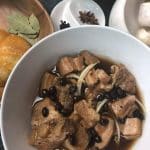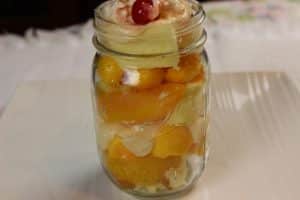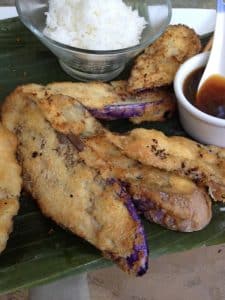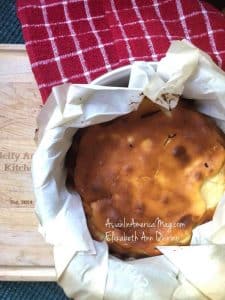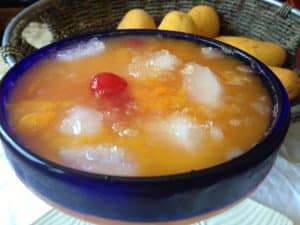Pork Humba
As an Amazon Associate and member of other affiliate programs, I earn from qualifying purchases.
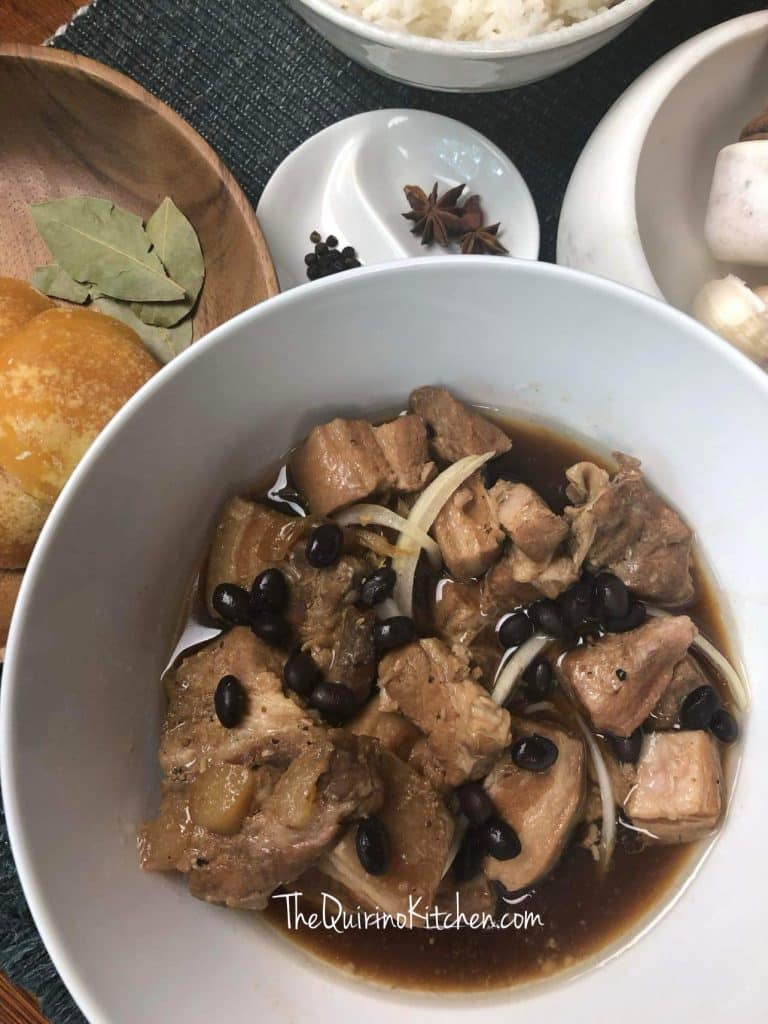
The classic Filipino Pork Humba is a sweet-savory stew of pork belly cubes simmered in soy sauce, vinegar, pineapple juice, tausi (fermented black beans), onions, garlic, sangke (star anise), peppercorns, salt and pepper. I have seen this pork dish served often in many Filipino households, whether it is an everyday meal or a party dish during town fiestas, birthdays, special occasions, and even as a popular entrée ordered in restaurants. The ease of cooking, plus the wholesome sweetness which complements the rice, an Asian staple makes this dish a crowd-pleaser.
What is Humba?
In the second edition of The Ultimate Filipino Adobo, author Claude Tayag goes deep into the description of the Humba. Chef Claude defines humba (say ‘hoom-bah’) as a close cousin of the Filipino adobo. He said “adobo is to Filipinos, as humba is to the Chinese community in the Philippines.”
Origins of the word humba come from the Chinese word ‘hong’, meaning to cook in an airtight container, while ‘ba’ means pork in Hokkien, according to Claude.
For most Filipinos, humba is sweet adobo. And specifically in the Visayas region, humba is a popular pork dish where most households in this provinces would have it ready in their kitchen.
How many Humba variations are there?
There are various home cooking recipe versions of humba in Filipino households. But there seems to be some common ingredients and flavors found in this braised pork stew. One finds pork belly cubes cooked in soy sauce, vinegar, tausi, garlic, star anise. Some versions have tahure (fermented soy bean paste), dried banana blossoms, peanuts, plus the seasonings.
Ingredients needed:
Here’s a list of what you need. The more detailed recipe can be found in the recipe card below.
- Tausi –These are Chinese fermented salted black beans. I used canned tausi.
- Pork belly, a pound, cut into 2-inch cubes.
- Soy sauce – I used Filipino brands, like Silver Swan
- White vinegar- I used the white distilled store-brand vinegar.
- Pineapple juice – to sweeten the pork stew
- Broth – pork , chicken or beef (or use water)
- Garlic cloves- simply peel them and add to the stew.
- Star anise – it is called ‘sangke’ in Pilipino. Shaped like a star, this spice gives off a strong licorice-like taste and aroma. Use only 2 or 3 of the star edges.
- Brown sugar – needed to sweeten the pork. I always add sugar last when the meat is nearly done. Sugar can burn the dish, so it’s best to add at the end of cooking.
- Dried bay leaves- make sure they’re newly-purchased. Bay leaves adds a slightly herbal, peppery flavor.
- Dried banana blossoms – This is optional. I sometimes use it to please the ancestors who may want the traditional way of cooking Humba. They look like dried yellow small stems. It adds to the sweetness and makes the sauce sticky and thick. This is sold in Asian or Filipino groceries here in America, or else online sources.
- Salt and black pepper
The cooking process and cooking it ahead:
Pork humba is one of the easiest Filipino stews to cook. The pork cubes are first braised, then toss in the rest of the ingredients in the stockpot. Simmer it all together till the meat is soft and tender, and the sauce has a sweet fragrance. Humba tastes salty and sweet at the same time, with a hint of a slight licorice flavor from the star anise. And one of the best things about this recipe is that you can make it ahead and store in the refrigerator or freezer. Simply thaw and reheat the day you serve it on the table.
How to store:
Store in a covered container in the refrigerator or freezer. In the refrigerator, Pork Humba can keep up to one week. In the freezer, in an airtight plastic container, this can keep up to one month.
Pork Humba
Equipment
- Assorted mixing bowls – small to large
- Large saucepan – 12 to 14-inches diameter
- Mortar and pestle
Ingredients
- 1/2 cup tausi (salted black beans, canned); drained
- 1 teaspoon baking soda
- 1 pound liempo (pork belly), cut in 2-inch cubes: trim fat if excessive
- 2 Tablespoons vegetable oil
- 1 whole medium-sized white or yellow onion, sliced
- 4 pieces garlic cloves, peeled
- 2 Tablespoons toyo (soy sauce), like Silver Swan
- 2 Tablespoons white vinegar, like Datu Puti or store-brand white distilled vinegar
- 3/4 cup pineapple juice
- 1 cup broth, use pork, beef or chicken
- 3 pieces star anise points (broken from 1 whole star piece)
- 2 pieces dried bay leaves
- 1/2 teaspoon salt
- 1/2 teaspoon ground black pepper
- 1/4 cup brown sugar
- 1/2 cup dried banana blossoms (optional)
For serving:
- steamed rice
Instructions
To prepare tausi (salted black beans)
- Drain the water from the canned salted black beans.In a medium-sized bowl, soak the black beans in water for 1 hour to soften, and to minimize the salty flavor.After 1 hour, drain the water. Rinse the black beans in running water. Then place in a colander to drain any excess liquid. Set aside.
To prepare pork belly cubes:
- In a medium-sized bowl place the pork belly cubes. Sprinkle the teaspoon of baking soda all over the meat. Blend the baking soda well into the meat. Let the baking soda stay on the meat for 30 minutes. This softens the pork cubes.After 30 minutes, wash off the baking soda from the pork cubes, through running water. Drain well. Set the pork aside.
To cook Pork Humba:
- In a saucepan, over medium heat, add the oil.When the oil is hot enough, saute the onions and garlic.Add the pork cubes. Braise the pork for about 3 to 5 minutes till brown on all sides.
- To the saucepan with the pork , add the soy sauce, vinegar, pineapple juice, broth, Then add the salted black beans, star anise and bay leaves.Season with salt and black pepper. Cover and simmer over medium heat, the pork for about 35 to 40 minutes till the meat is tender.
- When pork is nearly done, and is fork-tender, add the brown sugar and dried banana blossoms, if using. Mix well.Continue cooking over low heat for about 5 minutes more.When done, serve the Pork Humba warm with steamed rice.
Cook's comments:
- Trader Joe's Fully Cooked Pork Belly: When I am in a rush, and don't have time to tenderize the pork cubes, I use a kitchen hack – I use the Trader Joe's Fully Cooked Pork Belly. This whole slab of pork, sold at Trader Joe's grocery, is already pre-boiled, slightly salted, so it cuts the first few cooking steps. of a Pork Humba recipe. Cooking time is also done in 20 minutes if I use this kitchen hack. For this recipe, I used 2 packages (12 ounces each). These can be found at the chilled section of Trader Joe's.
Nutrition
Copyright Notice: Hello, Friends! Please DO NOT LIFT OR PLAGIARIZE The Quirino Kitchen recipes on this blog, my original recipes, stories, photos or videos. All the images and content on this blog are COPYRIGHT PROTECTED and owned by my media company Besa-Quirino LLC by Elizabeth Ann Quirino. This means BY LAW you are NOT allowed to copy, scrape, lift, frame, plagiarize or use my introductory recipe notes, photos, essays, stories and recipe content on your websites, books, films, television shows, videos, without my permission. If you wish to republish this recipe or content on media outlets mentioned above, please ASK MY PERMISSION, or re-write it in your own words and link back to my blog TheQuirinoKitchen.com to give proper attribution. It is the legal thing to do. Thank you. Email me at [email protected]

